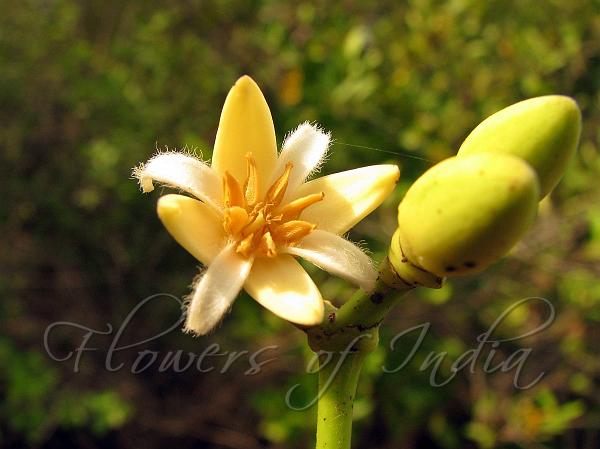|
| Asiatic Mangrove |
|

|

| File size | 504549 |
| Original date | 3/24/12 3:47 PM |
| Resolution | 2048 x 1536 |
| Flash | Flash did not fire, auto |
| Focal length | 6.0mm |
| Exposure time | 1/400s |
| Aperture | 4.0 |
| Focus Distance | |
| Metering Mode | Center weighted average |
| Camera make | Canon |
| Camera model | Canon PowerShot S5 IS |
| Sensor type | OneChipColorArea |
|
|
|
|
Photo: |
Botanical name: Rhizophora mucronata Family: Rhizophoraceae (Burma Mangrove family)
Asiatic Mangrove trees grow up to 20-25 m height. It has well developed
aerial stilt roots, which allow easy recognition of this species
Elliptical leaves are up to 25 cm long, 10 cm wide, but more commonly
around 12 cm x 6 cm. A long point is there at the end of the leaves up to
0.8 cm, but usually breaks off. Flowers occur as axillary inflorescences
and open within the leafy crown hanging downwards from a long peduncle.
Flowers have a yellow-white sepal-cup with 4 thick and hard sepals. When
the flower opens, the 4 white and hairy petals appear alternated with the
sepals. The seeds of the mangrove Rhizophoraceae are all viviparous.
Medicinal uses: It is used as an astringent and to treat
angina, haemorrhaging (extracts from the seedlings in Indochina);
diarrhoea (China, Japan): diabetes, dysentery, hematuria. A poultice of
the leaves are used to relief armoured fish stings. Old leaves and roots
are used during childbirth (Malay). Bark is used to treat blood in the
urine (Burma).
It is used as an astringent and to treat
angina, haemorrhaging (extracts from the seedlings in Indochina);
diarrhoea (China, Japan): diabetes, dysentery, hematuria. A poultice of
the leaves are used to relief armoured fish stings. Old leaves and roots
are used during childbirth (Malay). Bark is used to treat blood in the
urine (Burma).
Medicinal uses:
 It is used as an astringent and to treat
angina, haemorrhaging (extracts from the seedlings in Indochina);
diarrhoea (China, Japan): diabetes, dysentery, hematuria. A poultice of
the leaves are used to relief armoured fish stings. Old leaves and roots
are used during childbirth (Malay). Bark is used to treat blood in the
urine (Burma).
It is used as an astringent and to treat
angina, haemorrhaging (extracts from the seedlings in Indochina);
diarrhoea (China, Japan): diabetes, dysentery, hematuria. A poultice of
the leaves are used to relief armoured fish stings. Old leaves and roots
are used during childbirth (Malay). Bark is used to treat blood in the
urine (Burma). | Identification credit: Prashant Awale, Shrikant Ingalhalikar, Tanay Bose | Photographed near Ratnagiri, Maharashtra. |
• Is this flower misidentified? If yes,